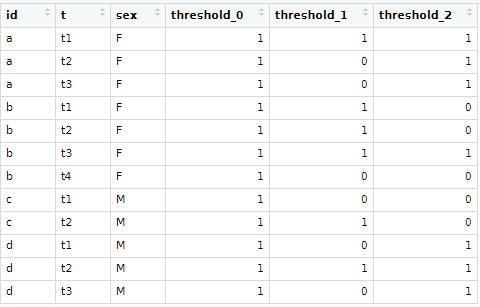Hello everyone,
I am a beginner on R trying to improve my skills!
In my dataset (see a small sample attached), I have different threshold values (0, 1 or 2 for example). For these thresholds, a value of 1 means that the individual (id) manifested the behaviour studied, 0 means the opposite. I would like to count for each threshold, the number of individuals that manifested the behaviour regardless of time.

For example, for threshold_0, the 4 individuals manifested the behaviour. But for threshold_2, only 3 manifested the behaviour (not individual c).
I thought about doing a for loop with which I would fill up the table with three columns (threshold, F and M (sex)). Only the "sex" columns would need to be filled with the number of individuals.
This is what I did... but it is obviously not working and I am blocked.
for (individual in unique(table$id)){
for (i in 2:20){ #This corresponds to the number of columns in my real dataset
if (any(table[[i]][table$id %in% individual] == 1)){ #Returns missing value where TRUE/FALSE needed
#Then I would like to add +1 in the right column and line of the latest table
}
}
}
Could anybody help me find potential solutions or a new method to complete this ?
Thank you!